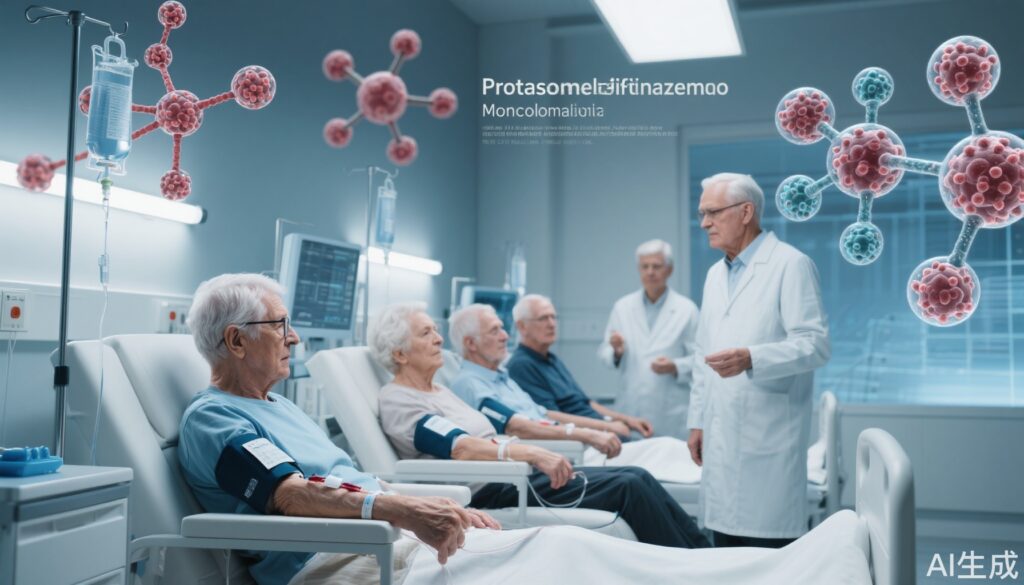Highlights
- KRd (carfilzomib, lenalidomide, dexamethasone) and D-KRd (with daratumumab) significantly increase rates of measurable residual disease (MRD) negativity compared to VMP 9-Rd 9 in older, fit, transplant-ineligible patients with newly diagnosed multiple myeloma.
- Quadruplet therapy (D-KRd) is associated with higher toxicity-related mortality, emphasizing the need for frailty-adapted treatment decisions.
- KRd demonstrated a favorable safety profile, especially regarding lower rates of severe neutropenia compared to other arms.
Study Background and Disease Burden
Multiple myeloma (MM) is a hematologic malignancy marked by clonal plasma cell proliferation in the bone marrow. While autologous stem cell transplantation remains standard for eligible patients, a substantial proportion—often older adults—are ineligible due to age or comorbidities. This group, representing a significant disease burden, faces both suboptimal outcomes and increased risks of treatment toxicity.
Recent advances have introduced triplet and quadruplet regimens incorporating proteasome inhibitors (like bortezomib or carfilzomib), immunomodulatory agents (lenalidomide), corticosteroids (dexamethasone or prednisone), and anti-CD38 monoclonal antibodies (daratumumab). Despite improved efficacy, these intensive regimens raise concerns about toxicity, especially in patients with varying degrees of frailty. Thus, optimizing therapy for fit, older, transplant-ineligible patients is a major unmet clinical need.
Study Design
The GEM-2017FIT study was a phase 3, open-label, multicenter, randomized trial conducted across 57 Spanish centers. Eligible participants were 65-80 years old, newly diagnosed with MM, and considered transplant-ineligible but otherwise fit, as assessed by the Geriatric Assessment in Hematology (GAH) scale.
Patients were randomized (1:1:1) to one of three arms:
- VMP 9-Rd 9: Nine cycles of bortezomib, melphalan, prednisone (VMP), followed by nine cycles of lenalidomide and dexamethasone (Rd).
- KRd: Eighteen cycles of carfilzomib, lenalidomide, and dexamethasone.
- D-KRd: Eighteen cycles of carfilzomib, lenalidomide, dexamethasone, plus daratumumab (quadruplet regimen).
After induction and consolidation, patients were stratified by MRD status and further randomized to maintenance therapy (daratumumab + lenalidomide) or observation. The primary endpoint was MRD negativity at a sensitivity of 10−5 post-induction (intention-to-treat population).
Key Findings
A total of 462 eligible patients (median age within 65-80 years, balanced gender distribution) underwent randomization. After a median follow-up of 33.15 months:
- MRD Negativity:
- KRd: 54% (83/154; OR 1.73, 95% CI 1.39-2.16; p<0.0001)
- D-KRd: 61% (94/153; OR 2.03, 1.61-2.57; p<0.0001)
- VMP 9-Rd 9: 27% (41/154)
- Hematologic Toxicity: Grade 3–4 neutropenia was less frequent in the KRd arm (24%) than VMP 9-Rd 9 (40%) or D-KRd (41%).
- Infectious Complications: Grade 3–4 infections occurred at similar rates across groups: VMP 9-Rd 9 (12%), KRd (15%), D-KRd (16%).
- Toxicity-Related Mortality: Comparable between VMP 9-Rd 9 (5%) and KRd (3%), but notably higher in D-KRd (8%).
These results indicate that both KRd and D-KRd regimens yield higher rates of deep remission (MRD negativity) compared to the traditional VMP-based sequence. However, the D-KRd arm exhibited a concerning increase in toxicity-related deaths, underscoring the delicate balance between efficacy and safety in this population.
Expert Commentary
The GEM-2017FIT trial provides critical evidence supporting the use of more potent induction regimens in older, fit, transplant-ineligible patients with newly diagnosed MM. Achieving MRD negativity is increasingly recognized as a surrogate for prolonged progression-free and overall survival in MM. These findings thus align with a trend toward more ambitious treatment goals, even in non-transplant candidates, provided that frailty and comorbidities are meticulously assessed.
However, the higher mortality observed with D-KRd mandates caution. Quadruplet regimens, while promising, require careful patient selection and vigilant supportive care. The similar infection rates but increased overall toxicity in the quadruplet group emphasize that therapeutic intensity should be individualized, not uniformly escalated.
These results also highlight the need for integrating frailty assessment tools—such as the GAH scale—into routine clinical decision-making, an approach echoed in recent guidelines (IMWG, ESMO). The trial’s design, featuring real-world age and fitness strata, enhances its external validity and clinical applicability.
Conclusion
KRd and D-KRd regimens represent significant advances in induction therapy for older, fit, transplant-ineligible patients with newly diagnosed multiple myeloma, offering higher rates of MRD negativity than the traditional VMP 9-Rd 9 sequence. Nonetheless, increased toxicity—particularly with quadruplet therapy—necessitates individualized, frailty-adapted treatment approaches. The integration of comprehensive geriatric assessment into therapeutic decision-making is paramount to maximize benefit and minimize harm in this vulnerable population. Ongoing research should further refine patient selection and supportive care strategies to safely extend these gains.
References
1. Mateos MV, Paiva B, Cedena MT, et al. Induction therapy with bortezomib, melphalan, and prednisone followed by lenalidomide and dexamethasone versus carfilzomib, lenalidomide, and dexamethasone with or without daratumumab in older, fit patients with newly diagnosed multiple myeloma (GEM-2017FIT): a phase 3, open-label, multicentre, randomised clinical trial. Lancet Haematol. 2025 Aug;12(8):e588-e598. doi: 10.1016/S2352-3026(25)00143-7. PMID: 40769684.
2. International Myeloma Working Group (IMWG) guidelines.
3. European Society for Medical Oncology (ESMO) Clinical Practice Guidelines for Multiple Myeloma.



